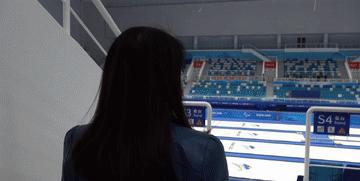The Ice Cube, the National Aquatics Center that retained the ice surface at the Beijing Winter Olympics, opened to the public on April 16 and attracted about 1,000 spectators on its first day. "Water ice conversion" is the unique feature of the National Aquatics Center, but also the dual drive of the National Aquatics Center, after the end of this month-long post-competition experience activities, some of the Winter Olympic landscape and temporary facilities will be removed, the ice surface is planned to be gradually restored to a swimming pool from mid-to-late May, and then implement the "water ice" two-way conversion according to the use needs. The Ice Cube Ice Sports Center, an underground ice rink on the south side of the venue, is expected to meet with the public in June.

Image source Xinhua News Agency
Also on April 16, the China Ice and Snow Night was held in the Capital Gymnasium, which not only showed the behind-the-scenes story of China's ice and snow, but also showed the "future possibilities" of the Capital Gymnasium, showing that it has all the elements to hold a high-level evening party, as well as the Winter Olympic level ice surface that is difficult for other venues to have - many Winter Olympic athletes and children wearing ice knives on their feet and performing programs around the venue.
Gao Tingyu appeared on the night of China's ice and snow, photographed by Wei Zheng
The Beijing Winter Olympic and Paralympic Winter Games have come to an end, and the post-Winter Olympic era has arrived, and the Winter Olympic venues will also usher in a new future. The post-game utilization of Olympic venues has always been a worldwide problem, and there are few global success stories. On April 15, Beijing Wukesong Culture and Sports Center hosted a "Summit Forum on the Post-Game Utilization of Winter Olympic Venues", inviting heads of sports management departments, business associations, colleges and universities and other institutions to discuss the use of venues in the post-Winter Olympic era.
The picture shows the night view of wukesong sports center. Xinhua News Agency
At the Beijing Winter Olympics, Wukesong Gymnasium was used as a venue for women's ice hockey and some men's ice hockey, and the newly built Wukesong Ice Sports Center was used as an ice hockey training hall. As a double Olympic venue, Wukesong Cultural and Sports Center has had a successful transformation after the 2008 Beijing Olympic Games, completing the expansion and transformation from a single venue to a comprehensive venue, from competitive sports to mass fitness, from cultural and sports landmarks to fashion life circles. "From the Summer Olympics to the Winter Olympics, we have made useful explorations in the reuse of the Olympic heritage, and also face new challenges in the post-Winter Olympic era." Yuan Yinghui, general manager of the brand media center of Wukesong Cultural and Sports Center, said.
In the post-Winter Olympic era, Wukesong Stadium continued the Olympic blood of basketball and ice hockey, and strived to introduce more events and performing arts activities. Wukesong Ice Sports Center will be transformed into a one-stop family lohas experience center - Bloomage LIVE Ice Center, becoming a service complex with ice rink as the core of sports and business integration, including ice sports, catering, culture, education, entertainment and other formats, to create a "one core, multiple formats, all-round" consumption model. It is currently the world's largest single-body ultra-low energy sports building, with 2 ice rinks, and is expected to officially open to the public in June.
"The Beijing Winter Olympics are a new starting point for the development of ice and snow sports in China, and the post-Winter Olympic era should further promote China's ice and snow with the help of the legacy of rich venue resources and other heritage." Li Xiaoming, director of the Ice Sports Center of the Beijing Municipal Sports Bureau, said.
The success of an Olympic Games lies not only in the wonderful presentation during the event, but also in the use of competition venues after the games. The post-game utilization of the Venues of the Beijing Winter Olympics has already determined a careful plan as early as the preparatory period, and is now being implemented intensively.